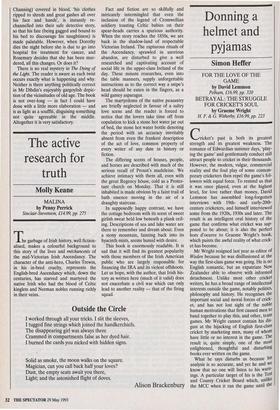The active research for truth
Molly Keane
MAUNA by Penny Perrick
Sinclair-Stevenson, f14.99, pp. 275
he garbage of Irish history, well fiction- alised, makes a colourful background to this story of the lives and michancetes of the mid-Victorian Irish Ascendancy. The character of the anti-hero, Charles Trewin, in his in-bred cruelty, represents the English-bred Ascendancy which, down the centuries, has starved and martyred the native Irish who had the blood of Celtic kinglets and Norman nobles running richly in their veins. Fact and fiction are so skilfully and intricately intermingled that even the inclusion of the legend of Cromwellian soldiery toasting Celtic babies on their spear-heads carries a spurious authority. When the story reaches the 1850s, we are back in the shadow-land of respectable Victorian Ireland. The rapturous rituals of the Ascendancy, sprawled in uxorious abandon, are disturbed to give a well researched and captivating account of social life in the upper-class Ireland of the day. These minute researches, even into the table manners, supply unforgettable instructions as to the correct way a snipe's head should be eaten in the fingers, as a wild gamey asparagus.
The martyrdoms of the native peasantry are briefly neglected in favour of a sultry love scene and the reader is forced to notice that the lovers take time off from copulation to kick a stone hot water jar out of bed, the stone hot water bottle denoting the period with an accuracy inevitably absent from even the frankest description of the act of love, common property of every writer of any date in history or fiction.
The differing scents of houses, people, and horses are described with much of the serious recall of Proust's madeleine. We achieve intimacy with them all, even with the great Regency Muse, cold as a Protes- tant church on Monday. That it is still inhabited is made obvious by a faint trail of bath essence moving in the air of a draughty staircase.
In supposedly happy contrast, we have the cottage bedroom with its scent of sweet girlish sweat held low beneath a plank ceil- ing. Descriptions of sea and lake water are there to remember and dream about. Even a stony mountain, fainting back into its hyacinth mists, seems humid with desire.
This book is enormously readable. It is sad that it will find its greatest popularity with those members of the Irish American public who are largely responsible for financing the IRA and its violent offshoots. Let us hope, with the author, that Irish his- tory as written here (much of it valid) does not exacerbate a civil war which can only lead to another reality — that of the firing squad.


















































 Previous page
Previous page